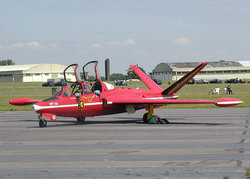Trainer (aircraft)
|
|
A trainer is a training aircraft used to develop piloting, navigational or weapon-aiming skills in flight crew.
They have two or more crew seats. Civilian pilots are normally trained in a light aircraft that may be modified from a type primarily built for recreational or aerobatic flying. Some such aircraft, often adapted to withstand more rigorous flight conditions, are often utilised to train military pilots. Some air forces contract-out training activities to private companies, or arrange for military officers to train using aircraft provided and maintained by a private business.

Some military training aircraft are twin-seat versions of combat aircraft types (ground-attack or interceptor) and some of these are capable of rapid conversion in times of emergency to a reconnaissance or combat role. For smaller air forces, such adaptability can have important economic benefits. This convertibility brings with it political risks, in recent years the sale of Hawk aircraft by British Aerospace to Indonesia has, for example, been highly contentious.
A minority of military training aircraft, such as the Vickers Varsity or HS125 Dominie were developed from light transport designs to train several navigators at the same time. As these navigational trainees are normally learning how to navigate using instruments, they can be seated at consoles within the aircraft cabin and do not require a direct view of the landscape over which the aircraft is flying. The operators of airborne weapons or radar-related systems can be similarly trained, either in training aircraft or in an operational aircraft during training flights.
As the costs of developing aircraft have risen in real terms, partly due to the increased sophistication of systems and safety features, so it has become much less likely that aircraft will be designed specifically for the training role. Classic training types were the De Havilland Tiger Moth, the North American Texan (Harvard in many countries) and the De Havilland Chipmunk. Some jet trainers, such as the Aermacchi MB-326, Folland Gnat, Fouga Magister and British Aerospace Hawk, have become famous through their use by national formation aerobatic teams. Early jet aerobatic teams tended to use combat types such as the Hawker Hunter, English Electric Lightning, and North American F-100 Super Sabre. As air forces became subject to stronger economic pressures and their combat fleets were scaled-down, it made sense for most national teams to change to lighter training types. A few aircraft modifications may be needed to enable coloured smoke to be emitted during aerial displays for visual effect, but essentially these airframes remain valuable to perform their pilot training function.
For reasons of safety and efficiency, much training is now carried out on simulators that can be positioned in buildings on the ground. A different simulator may be required to simulate each specific type of aircraft that the trainee hopes to fly.
|
Lists of Aircraft | Aircraft manufacturers | Aircraft engines | Aircraft engine manufacturers Airports | Airlines | Air forces | Aircraft weapons | Missiles | Timeline of aviation |
